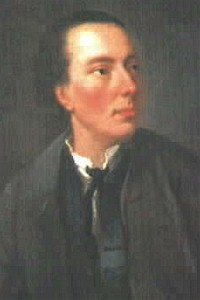Charles Avison facts for kids
Charles Avison (born in 1709, died in 1770) was an English composer. He lived during the Baroque and Classical music times. He worked as a church organist in Newcastle at St John The Baptist Church and St. Nicholas's Church.
Avison is best known for his 12 Concerti Grossi after Scarlatti. He also wrote an important book called Essay on Musical Expression. This was the first time someone published music criticism in English. His music style was a mix of Baroque and Classical.
Contents
Life
Charles Avison was born in Newcastle. He was baptised on February 16, 1709. His father was a musician and probably taught Charles music first. When Charles was 12, his father died.
When he was in his twenties, Avison moved to London to become a better musician. There, he studied with a famous musician named Francesco Geminiani. Avison's first known concert was in London in 1734. This was his only known concert in London.
In 1735, Avison went back to Newcastle. He became the organist at St. John's Church. A year later, he also became the organist at St. Nicholas Church. He was also made the director of the Newcastle Musical Society. He stayed in these jobs until he died. Avison also taught music lessons, like harpsichord, flute, and violin. He helped start the first public concerts in Newcastle. Even though he got offers for bigger jobs, he never left Newcastle again.
Avison married Catherine Reynolds in 1737. They had nine children, but only three lived to be adults: Jane, Edward, and Charles. Edward became the director of the Newcastle Musical Society and the St. Nicholas's organist after his father. Charles also became an organist and composer.
Charles Avison died in May 1770 when he was 61 years old. He was a wealthy man when he died. He owned many books, musical instruments, and investments. He was buried next to his wife at St Andrew's Church, Newcastle upon Tyne.
Writings
Avison was a brave writer who wasn't afraid to share his strong ideas. He wrote with clear language and a good understanding of music. He often gave his opinions about other composers. For example, he liked Geminiani and Marcello more than Handel. Even though he thought Handel was a genius, he still criticised him. Avison also wrote long introductions to his music pieces.
Essay on Musical Expression
Avison's most famous writing is his Essay on Musical Expression. It was first published in 1752. This essay had three parts.
The first part talks about how music affects our feelings. Avison compared music to painting. He said that beautiful music is just as wonderful to hear as beautiful colors are to see. He also believed that music brings out positive feelings and helps to stop negative ones.
The second part of the essay looks at different composers and their styles. Avison talked about how some composers focused too much on melody and not enough on harmony, or vice versa. He believed that good musical expression needs a balance between melody and harmony. He wrote, "Melody and Harmony are never to be left out for the sake of expression: because expression is built on them." Avison was very direct when he criticised composers.
The third part of the essay shared Avison's ideas on how different instruments should be used in groups, especially in concertos. For example, he said that the Hautboy (an old type of oboe) is best for a singing style of music.
Many people thought this essay was very opinionated and caused arguments. In 1753, another writer named William Hayes wrote a review criticising Avison's essay. Avison then wrote a response to Hayes.
Compositions
Avison's most famous music pieces are his concerti grossi. These are like concertos for a group of instruments. They are similar to the music of Geminiani. Some of Avison's concertos were based on music by the Italian composer Domenico Scarlatti. Avison thought melody was very important in his music. Because of this, his pieces are known for being "unusually tuneful."
Avison also wrote chamber music. This is music for a small group of instruments. His early chamber pieces were in the Baroque style. Later, his chamber works were for keyboard with other instruments like flute and violin. Avison also wrote a small amount of sacred music (religious music), including a hymn and a chant. He also worked with Felice Giardini on an oratorio called Ruth.
Orchestral Music
- Op. 2 Six Concertos
- Two Concertos
- Op. 3 Six Concertos – With General Rules for Playing
- Op. 4 Eight Concertos
- Op. 6 Twelve Concertos
- Op. 9 Twelve Concertos
- Op. 10 Six Concertos
Chamber Music
- Op. 1 VI Sonatas
- Op. 5 Six Sonatas
- Op. 7 Six Sonatas
- Op. 8 Six Sonatas
Other Music
- "Hast thou not forsaken us" (a type of church song)
- "Glory to God" (Christmas Hymn/Sanctus)
- "Ruth" (an oratorio, written with Giardini)
- "Psalm LVII" (a chant)
Influence
Avison helped continue the Italian music style in England. His Concerti Grossi were inspired by older composers. His Essay on Musical Expression criticised Handel, who was very popular in England at the time.
Since 1994, a group called the Avison Ensemble in Newcastle has been playing Avison's music using old instruments.
The City Library building in Newcastle, which opened in 2009, was named after Charles Avison. The library also keeps his old papers and music.
In 2014, a play about Avison called Mostra was performed in Gateshead. It was described as "a play with live music about our very own 18th Century Newcastle composer."



